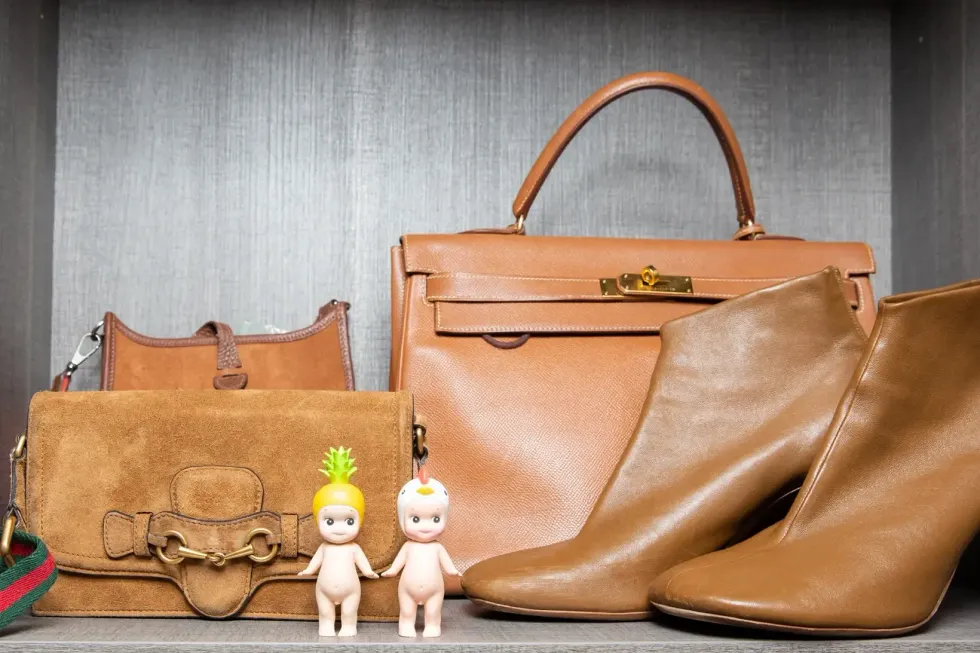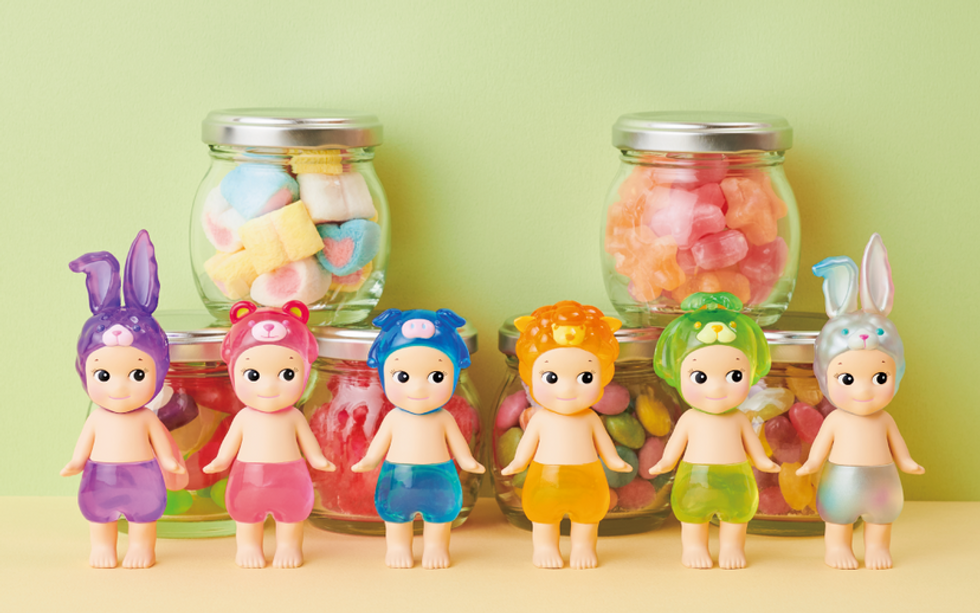What’s Behind This Wave of Inner-Child Consumerism?
Exploring the Millennial phenomenon of toy collecting through the lens of a 3-inch tall angel with headgear. |

My journey into the realm of childhood toys followed a fairly classic narrative. I began with a stuffed animal and a baby doll (both named Tony), then later graduated to Calico Critters and Polly Pockets—resulting in a penchant for chewing on every item in Polly’s wardrobe. The smaller the toy, the more magnetized I was. As I got older, these toys were replaced with more age-appropriate interests—Tumblr, iChat, and crushes—but it appears there has been a sudden renewed interest in the commodities of our early childhood. And I’m not talking about those basement-dwelling, comic-book-collecting dweebs. Believe it or not, this new phenomenon is a hot girl trend.
In the ever-evolving landscape of pseudo-adulthood (those of us gracefully navigating our mid to late 20s), there has been an overwhelming pop-psychology imperative to ‘heal your inner child.’ This narrative arose in tandem with commodities and collectibles that seem, in nature, catered to children but are, in fact, marketed to adults (specifically millennials). Whether it is a coincidence or a genius ploy of late-stage capitalism, we’ve taken the bait—collectible toys are all the rage. So what does this new trend stem from? A desire to create a community divorced from our jobs? A distraction from the stress of daily life? Post-pandemic regression? Y2K nostalgia? An attempt to heal that insatiable inner child? Regardless of the reason, I am thrilled to announce that you can officially consider collectibles cool. Enter: Sonny Angel.
Sonny Angel, a line of miniature dolls created by a Japanese toy manufacturer and inspired by the cartoon character, Kewpie, has experienced a boom in popularity in the last few years alone (the brand first graced the market in the early 2000s). Thanks to content creators unveiling mystery unboxings, showcasing prized collections, and even fashioning bespoke outfits for their Sonny Angel dolls, a vibrant community has emerged. Individuals navigating the complexities of their mid-20s have come together seeking solace from their taxing adult routines and basking in the unbridled joy of child-like bliss.
My grand entrance into the world of Sonny Angel began when my friend enlisted me to help source these dolls for District, a start-up for collectors of all kinds to buy, sell, trade, and chat all under one digital roof. It wasn’t until I realized that there was a Sonny Angel shortage (i.e., people frantically TikTok-ing their city-wide scavenger hunts, attending meet-ups resembling secret societies, and a frenzied willingness to drop a small fortune on rare Sonny Angel dolls) that they piqued my interest, which quickly evolved into a full-blown obsession. Scarcity and demand? Count me in.
Following the traditional nature of blind boxes, similar to kidrobot or Happy Meal toys, the contents of Sonny Angel’s packaging are hidden until purchased and opened. After I struck Sonny Angel gold by opening the elusive Robby (Sonny’s rare friend with a 1/144 chance of finding), I decided to ride the high straight to An.mé, a female owned boutique with countless Sonny Angels to choose from, and famous for hosting meet-up events for Sonny Angel collectors. Following my usual routine I selected a box that seemed to be calling my name, chose which Sonny Angel I hoped was in the box, and unabashedly embarked on a full unboxing spectacle right in the middle of the store. Once the theatrics were done, I ended up with a Sonny Angel Hipper with a mushroom on his head (for non Angel-heads, ‘Hippers’ have adhesive tape on their stomachs, allowing you to stick them to any surface). On a gambler’s high, I fought the urge to pick another one off the shelf and repeat the entire process.
Leaving the store, my friend expressed her newfound desire for one—specifically the cherry—to hang on her phone. She was almost certain that this must be something I used to engage with as a kid, and was even confused why she never had them when she was younger. While they continue to grow in popularity, Sonny Angels weren’t in our cultural lexicon as kids. This wasn’t an example of the conventional nostalgia associated with reclaiming items from our past; instead, it was a pursuit of a particular feeling.
In my experience, this feeling was created by chasing a moment of what I would like to coin as a ‘controlled unknown.’ While life’s uncertainties typically provoke anxiety, this controlled unknown is akin to a surprise party that your best friend warned you about—allowing you to show up looking your best without the stress of planning. With blind boxes, you are able to control which series you get, pick the box that resonates most with you, and if the contents disappoint, the stakes remain low.
Luckily, if you don’t like the hand you were dealt, the resale market for Sonny Angels is a great place to sell less desirable dolls or duplicates, buy one to complete your series collection, or browse previous limited edition collections. With a variety of collections (animals, fruit, hippers, candy), each Sonny Angel Doll has its own resale value depending on how rare they are. Typically priced at $12 in stores, many are on the resale market for upwards of $200. These margins are a collector’s dream.
For the record, I've never been one to enthusiastically adopt hobbies. High school tennis was a fleeting affair—prompted more by the allure of cute uniforms than a genuine love for the sport. Knitting briefly captured my attention, but only as an excuse to explore a yarn store in the neighborhood. It wasn’t until the very sophisticated age of 26 that I stumbled upon a hobby that defied the usual one-month expiration date. Yet, while Sonny Angel dolls are my personal trending fixation, other child-like commodities are undergoing a renaissance of their own. From the Barbie movie to Kylie Jenner’s Bratz collab to brands like Starface creating stickers (now with the practical twist of addressing acne rather than for frivolous adornment), the Y2K aesthetic has transcended fashion into our daily preferences.
Jemma Sbeghen, the host of the podcast The Psychology of Your 20s, sees our collective fixation on the early 2000s as the nostalgia of our generation. Explaining that the memories of our past bring comfort because we already know the ending, Sbeghen says, “There’s nothing to be uncertain about, and therefore, nothing that feels unsafe in the safety of what we already know.” Sbeghen believes that inner-child healing has a whole new wave of proponents thanks to social media, creating a collective awareness and, therefore, a trending therapeutic movement of sorts. While acknowledging the impossibility of altering past events, the podcast host suggests a compelling alternative: the opportunity for self-reparenting.
In many cases, this involves purchasing items that recreate childhood experiences that activate our nostalgia; we can feel young again while also restoring a sense of control. As a response, companies have marketed this gravitation towards nostalgia to capitalize on this cultural “trend.” Sbeghen also believes that this tendency is driven by escapism—”the need to find a distraction from the mundane or stressful aspects of our daily life. Reverting back to past comforts allows us to feel like it is a simpler time.” While she believes that some might call this avoidance, Sbeghen sees this as a normal and healthy withdrawal from the discomforts of daily life. Just as one would turn to exercise or even drugs and alcohol, others turn to play and nostalgia.
Our Social Media Editor (and fellow Sonny Angel enthusiast), Sarah Lou Kiernan, has boiled this cultural shift down to the byproduct of late-stage capitalism, explaining that buying has become the fast track to dopamine while living and working in the city. Whether you align with this theory of “late-stage capitalism” or not, one thing is unequivocally clear: nostalgia is making a formidable comeback. But why? Are we, as a generation, collectively resisting the siren call of adulthood? Perhaps, rather than reminiscing on the ‘70s and ‘80s as ‘the good old days’ like our parents, we find comfort in objects from our past—even if we've gracefully exited the age range on the toy box.
While I may have succumbed to the allure of inner-child consumerism, I can’t claim that my inner child has undergone an ayahuasca-esque healing journey. Nevertheless, I experienced an immediate bliss upon purchase, allowing me, even for just a moment, to disconnect from my day-to-day routine and experience the thrill of an unknown yet controlled surprise. While Sonny Angel consumers have primarily attracted younger millennials, nostalgia knows no generational bounds. Whether it’s the era of Beanie Babies, the supposed charm of Cabbage Patch Dolls, or even Gen X’s Pet Rocks, this connection between collectibility and nostalgia attracts a loyal cult following. So, is each Sonny Angel I buy just a visual representation of my desire to disassociate from the anxieties of daily life? With a Sonny Angel hanging from my work laptop and an algorithm entrenched in Sonny Angel Tok, is this a hobby or a full-blown addiction? And as far as addictions and coping mechanisms go, isn't this one fairly innocuous? Whichever way you slice it, it's a whole lot cheaper than therapy.







